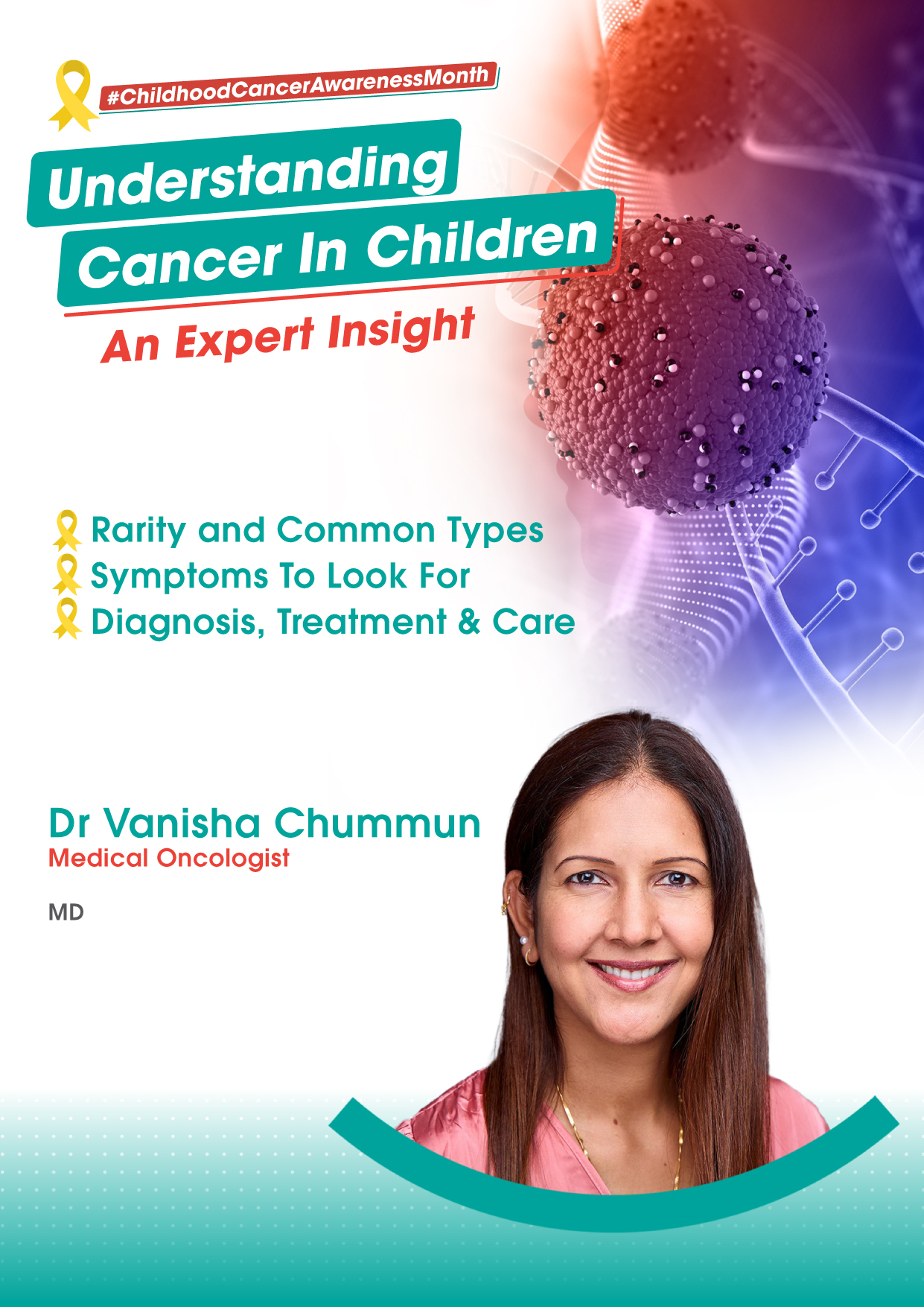
An Insight from Dr. Vanisha Chummun, Medical Oncologist
In recognition of National Childhood Cancer Awareness Month, we spoke with Dr. Vanisha Chummun about the realities of childhood cancer — a rare but life‑changing diagnosis. She shares what every parent, teacher and caregiver should know: the signs to watch for, how diagnosis and treatment work and why early action can save lives.
- How common is childhood cancer and which types are most prevalent?
Childhood cancer is rare, accounting for less than 1% of all cancers in Mauritius. In 2023, the Mauritius National Cancer Registry recorded 2,841 new cancer cases, with only a small fraction in children aged 0–14.
Globally, around 400,000 children and adolescents are diagnosed each year. The most common types are:
- Leukaemia – about 28% of cases, often between ages 2–10
- Central nervous system cancers – 26%, including brain and spinal cord tumours
- Neuroblastoma – 6%, a rare nerve tissue cancer
- Nephroblastoma (Wilms tumour) – kidney cancer in children
- Lymphomas – cancers of the lymphatic system
- Bone cancers – such as osteosarcoma and Ewing sarcoma
While the numbers are small compared to adult cancers, the impact on young patients and their families is profound — and awareness is key.
- What signs should parents and caregivers look out for?
Most symptoms will not be cancer, but if they persist or cause concern, a doctor should review the child promptly. Early detection greatly improves treatment success.
Warning signs include:
- Unexplained weight loss, persistent sickness or nausea
- Paleness or a swollen abdomen
- Ongoing pain, a new limp or slow recovery from injury
- Unusual bleeding, excessive bruising or blood in urine
- Constant tiredness or irritability
- Recurring fevers or night sweats
- Vision changes such as a new squint, unusual pupils or headaches
- Persistent swelling or a lump
- How is childhood cancer diagnosed and treated?
Diagnosis begins with a clinical evaluation and physical examination. If cancer is suspected, doctors may order blood tests, imaging scans (X‑ray, ultrasound, CT, MRI) and sometimes bone marrow aspiration. The most crucial step is a biopsy which confirms the cancer type and stage.
Treatment depends on the type and stage but often combines:
- Chemotherapy – the most common, given in cycles
- Surgery – to remove tumours
- Radiotherapy – used less often in very young children
- Targeted therapy – attacks specific cancer cell markers
- Immunotherapy – boosts the immune system
Supportive care walks alongside each child and family, easing side effects, nourishing the body and nurturing the heart and mind throughout the journey.
- What does recovery look like and what gives you hope?
Recovery is gradual and varies for each child. In remission, there are no detectable signs of cancer but follow‑up care remains vital to monitor for relapse and manage long‑term effects. Many children return to school, play and normal routines often with support to rebuild strength and confidence.
Advances in treatment — from precision medicine to improved supportive care — mean survival rates have improved significantly. Many survivors go on to live full, healthy lives.
- What message would you share with families facing a diagnosis?
A childhood cancer diagnosis is overwhelming but you are not alone. Many children recover thanks to modern treatments and dedicated medical teams.
What makes the biggest difference:
- Acting quickly when symptoms appear
- Following the treatment plan closely
- Strong family and community support
Parents and caregivers should also care for their own wellbeing, trust their medical team and seek emotional support. Hope, resilience and community are powerful allies in this journey.
Childhood cancer is rare — but awareness saves lives. By knowing the signs, challenging myths and supporting affected families, we can all help give children with cancer the greatest gift of all: the chance to grow up, dream big and live fully.
About Dr. Vanisha Chummun
Dr. Vanisha Chummun is a dedicated Medical Oncologist, committed to providing compassionate, evidence‑based cancer care to patients and their families. She holds an MD in Oncology from Huazhong University of Science and Technology in Wuhan, China and has been practising as a medical oncologist since 2018, building on over a decade of experience in the medical field.
Her core mission is to deliver personalised treatment plans that combine advanced medical therapies with holistic support, ensuring patients receive not only the best clinical care but also the emotional and nutritional guidance needed throughout their journey.
Dr. Chummun works closely with multidisciplinary teams to address the physical, psychological and social aspects of cancer treatment, with a special interest in raising awareness about early detection and prevention.
She carries out clinical work, where she is known for her approachable manner, clear communication and dedication to patient education. Dr. Chummun also actively participates in public health initiatives and awareness campaigns, aiming to demystify cancer and empower communities with knowledge.

